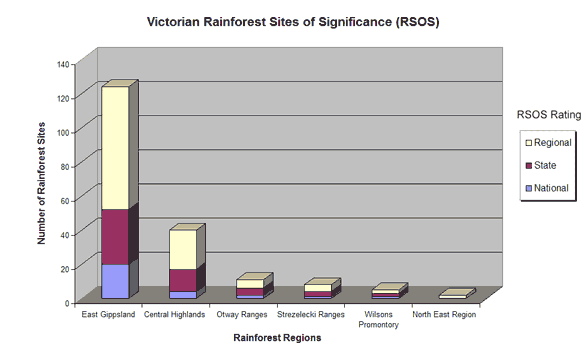 |
|||
|
Logging
of Victoria's Rainforest Heritage Since
1986 the National Rainforest Conservation Project Three Victorian regions have significant rainforest sites under threat from logging and roading operations. This logging activity is in breach of the Forest Code Of Practice. Central
Highlands Breaching the Forest Code of Practice: The Code of Forest Practice (s.2.3.7, pg. 24) precludes logging within rainforest sites of national significance. Section 2.3.7iii of the Code states that: "For stands containing nationally significant rainforest - the highest degree of protection, generally sub-catchment level, except where full protection can be provided by other measures, which are/will be outlined in approved plans." The currently approved 'detailed' strategy plans for rainforest protection fail to meet the code of practices' minimum requirements. These "other measures" are outlined in the Forest Management Plan and generally allow logging inside the subcatchment buffer surrounding nationally significant rainforest stands. At present, this section of the code is not audited by the Environment Protection Authority (EPA). Without thorough audits of the rainforest planning and management process, the community cannot be assured of the quality and effectiveness of existing management plans to protect our rarest and most significant rainforests. Existing 'approved plans' also permit logging within 40m of Myrtle Beech dominated rainforest. According to the Dandenong and Central Highlands Forest Management Plan's 'detailed' Management Prescriptions for Cool Temperate Rainforest: "40m [buffer] for priority 3 and 4 areas within sites of State significance and all sites of regional or local significance [are applicable]" (Central Highlands Forest Management Plan, 1998: p.14) . Yet according to Section 2.3.7ii of the Code of Forest Practice: "For stands where Nothofagus (Myrtle Beech) makes up >20% of the canopy- buffers of 60m, or 40m buffer with 40m modified harvesting zone [apply]" (pg.24) Section 2.3.7i of the Code sets out minimum 40m buffers for rainforest. The DSE however apply a minimum 20m rainforest buffer in East Gippsland. These buffer discrepancies result in substandard 'approved' plans for rainforest protection, as the Forest Management Planning Management Prescriptions do not exceed the minimum requirements outlined by the Code of Forest Practice. As explained in "Section 2- Application of the Code": "The goals and guidelines [of the Code] are to be used during the formulation of more detailed plans and prescriptions compiled for application to specific forest areas. These plans and prescriptions must be consistent with the Code and will exceed the minimum requirements outlined in the Code where necessary to protect environmental values." (Code of Forest Practice, Revision 2, 1996: 13) Furthermore, the release of the Flora and Fauna Guarantee (FFG)Act Action Statement on Rainforest protection is imminent, after nearly 12 years of delays and promises of completion. This critical Action Statement is reasonably expected to strengthen the code of forest practice, which sets out only "interim minimums" for rainforest protection. Logging within Rainforest Sites of Significance just prior to the release of the Rainforest Action Statement threatens to pre-empt the outcomes of a long overdue review of rainforest management prescriptions and guidelines. The continuation of logging allowed under current logging plans threatens to pre-empt the FFG Action Statement's new management prescriptions and guidelines. It is not unreasonable to presume that current RSOS logging operations are designed to circumvent the tighter logging restrictions likely to be introduced by the FFG Action Statement in the near future. In principle, no Rainforest Site of Significance should ever be logged. All logging and roading operations in sites of significance should cease until the long overdue Action Statement for rainforests is finally released and incorporated into regional forest management plans. What
are Rainforest Sites of Significance (RSOS)? 1.
Ecological integrity and viability The principal criteria guiding the delineation of sites of significance is the principle of catchment or sub catchment integrity. Intact catchments are relatively pristine areas of forest that buffer or shelter vulnerable rainforest stands from severe disturbance such as wildfire and logging. Logging disturbs these rainforest catchments, exposing them to 'edge effects' such as weed invasion, water siltation and in some circumstances, can elevate certain fire risks. Clearfell logging and roading operations can considerably alter fire behavior by replacing older, moist forests with low levels of ground fuel, into densely packed, dryer forests with high levels of ground fuel. The higher fuel loads of young regenerating forest can elevate the intensity and rate of spread of catastrophic wildfires burning towards core rainforest areas. The lower stand height of young regenerating trees compared to the larger trees of mature forests, can also promote a very destructive crown fire within the rainforest. Very hot and fast spreading fires which burn directly into the rainforest canopy, have the capacity to destroy fire-intolerant rainforests, replacing them with fire adapted eucalyptus forests. Recent observations based on aerial photography suggest that Cool Temperate Rainforest surrounded by substantial areas of mature forest is more likely to survive wildfire than rainforest surrounded by immature forests. |
|||
 |
|||
 |
|||
 |
|||
 |
|||
|
|
|||

